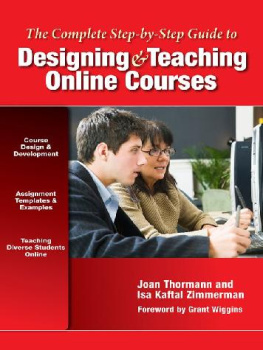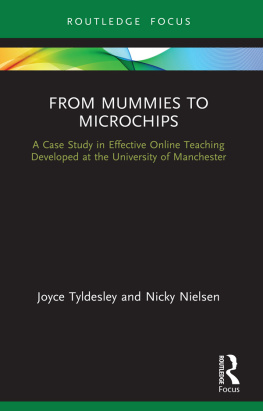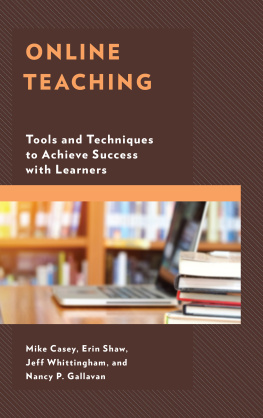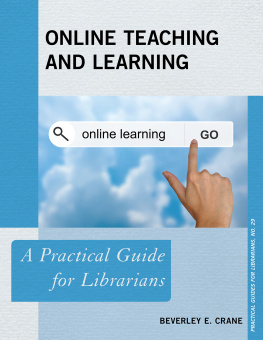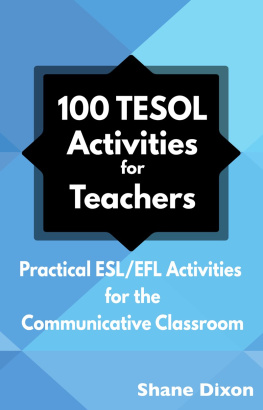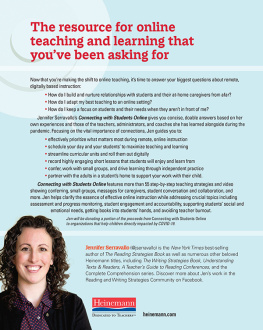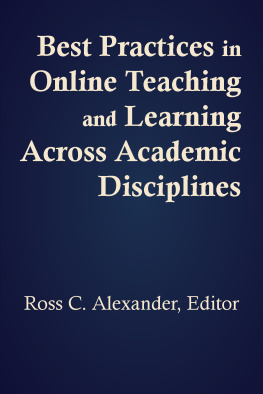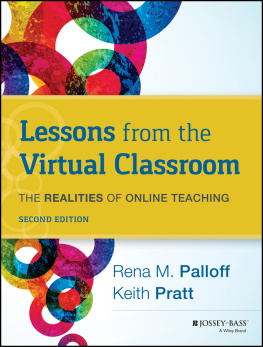The Complete Step-by-Step Guide to Designing and Teaching Online Courses
The Complete Step-by-Step Guide to Designing and Teaching Online Courses
Joan Thormann
Isa Kaftal Zimmerman
Foreword by Grant Wiggins

Teachers College
Columbia University
New York and London
Published by Teachers College Press, 1234 Amsterdam Avenue, New York, NY 10027
contain screenshots from Blackboard. Used with permission.
). Used with permission from the Advanced Learning Technologies in Education Consortia (ALTEC).
Copyright 2012 by Joan Thormann and Isa Kaftal Zimmerman
All rights reserved. No part of this publication may be reproduced or transmitted in any form or by any means, electronic or mechanical, including photocopy, or any information storage and retrieval system, without permission from the publisher.
Library of Congress Cataloging-in-Publication Data
Thormann, Joan, 1945-
The complete step-by-step guide to designing and teaching online courses / Joan Thormann, Isa Kaftal Zimmerman; foreword by Grant Wiggins. p. cm. Includes bibliographical references and index. ISBN: 978-0-8077-5309-5 (pbk.: alk. paper) 1. Web-based instruction. 2. Instructional systemsDesign. I. Zimmerman, Isa Kaftal. II. Title. LB1044.87.T57 2012 371.3344678dc23 2011050710 ISBN: 978-0-8077-5309-5 (paper) eISBN: 978-0-8077-7316-1
Contents
Foreword
You cant wing it in an online course as an instructor. There are countless logistic, technical, and planning issues to consider as you work, step-by-step, to build an effective and engaging experience for users.
There is a more pressing social reason to consult this book as a guide: while online learning is growing by leaps and bounds, there has been little quality control to ensure that the experience is a good one for learners. I have seen dozens of online courses, from both individual teachers and big commercial vendors, and most of them are of poor pedagogical quality: a high-tech way to deliver low-level information.
So, on many counts, it comes as a great relief and delight to have this guide by Joan Thormann and Isa Kaftal Zimmerman to take you through your paces and avoid all the many pitfalls of online course development. Its a near-perfect blend of theory and practice: advice on the pedagogy and practical tips on how to make the user feel comfortable; an overview of the history of online learning and concrete templates and worksheets for building a robust and coherent course.
Indeed, many of these chapters provide invaluable tools for any teacher, in any teaching situation or school. provide an elegant solution to a common problem for all educators: how to give many students custom feedback as efficiently as possible. Finally, their rich experience also shows in their clear and helpful counsel on how to deal with (inevitable) plagiarism as part of the excellent chapter on dilemmas. This is must reading for all teachers, online instructors or not, who are striving for intellectual integrity and honesty in their work as learners.
In short, this is a rare book in education: one that is not only highly useful but also intellectually coherent and based on robust, transferable principles of learning and teaching. All educatorsin online environments and in brick-and-mortar schoolswill find this an invaluable resource.
Grant Wiggins
Acknowledgments
Thanks to the organizations and individuals who supported us in this project. Lesley University granted Joan a sabbatical, a Russell Fellowship, and a Faculty Development Grant, all of which allowed her the time to focus on writing this book. In addition, Lesley provided a skilled and helpful assistant, Maggi Smith-Dalton, through the Graduate Assistant Program.
We appreciated the time generously given to us by our colleagues and friends. They include Diana Bander, George Blakeslee, Susan Cusack, Chris Dede, Joo Fernandes, Joo Freitas, Kathleen Fulton, Iris Geik, Barbara Gibson, Sarah Haavind, Jim Keefe, Dan Lake, Romeo Marquis, Steve Mashburn, Linda Triplett, and Maureen Yoder. Over the years, we have learned a tremendous amount from our students, and for this we are extremely grateful.
A special thanks to Gail Greenberg, who cheered us on and gave us useful feedback. Thanks to Ingrid Hahn for allowing Joan to use her serene refuge high above Lago Maggiore. Thanks also to Mike Thormann for his warm and gracious hospitality in allowing Joan to use his Florida home.
Last and most important, thanks to our husbands. To Joans wonderful husband, Judah Schwartz, who read, rearranged, and edited; he gave an occasional needed word and his constant support and encouragement. Thanks to Isas remarkable husband, George Zimmerman, who provided support and patience.
CHAPTER 1
Introduction; and How to Use This Book
We are living in a world of unprecedented change. The evolution of technology is more accurately described as the revolution of technology. Products are regularly updated or reinvented.
Although less has changed in education than in other sectors, there have been some significant developments. Alternative approaches and formats have emerged: charter schools, virtual schools, online and blended learning , longer school days and years, more time-on-task, after-school programs, and home schooling. These alternatives signal that competition from differing practices and formats will change traditional brick-and-mortar schooling. The one-educator-to-25-students paradigm will continue to shift. There is no going back to a world that does not use technology in teaching and learning. Online learning in particular is becoming an important aspect of all levels of education. As Kathleen Fulton of the National Commission on Teaching and Americas Future (NCTAF) has stated,
The reality is that a blended form of learning is already central to education today, with students supplementing face-to-face classes with online courses when they arent offered at their home schools, or when they dont have a chance to do regular schooling (when homebound due to illness or injury, incarcerated, travelling or other special cases). And of course, for home schooling, it can be the difference between having a limited repertoire of teaching and the world of courses and teachers available to them. In higher education the online learning opportunities are endlessand very profitable for higher education providersso likely only to expand (email communication, November 2010)
IMPACT OF ONLINE TEACHING AND LEARNING: TRANSFORMATIONS IN SCHOOLING
The International Association for K12 Online Learning (iNACOL) reports that 45 of the 50 states and the District of Columbia provide some form of virtual education. Many virtual schools show annual growth rates between 20% and 45%. iNACOL (2010) also found that 72% of school districts with distance education programs planned to expand online offerings in the coming year (p. 1).
These data show the movement toward online learning in K12. Students can now have access to courses and learning experiences that are not available locally or that are not offered because of underenrollment. Online courses provide access to expert knowledge and resources. Students are not constrained by time and place and can learn with other students from all over the world. Private companies, state agencies, and school districts are developing or seeking out courses for K12 students.
According to Allen and Seaman (2010), Online enrollments in U.S. higher education show no signs of slowing. More than one out of four college and university students now take at least one course online (p. 1). Some universities have established entire departments to help instructors understand how to teach online, and some, like the University of Southern California, have put whole degree programs online.
Next page
